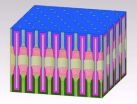(Press-News.org) Cold Spring Harbor, NY - Think about all the things you are doing at this moment. As your eyes scan across the lines of this article, maybe your brain is processing the smell of coffee brewing down the hall and the sound of leaf blowers outside your window. Maybe you are tapping your foot and spinning a pen between your fingers. At any given moment, your brain is simultaneously processing a multitude of information from your senses while supporting a dizzying array of behaviors.
How is all this information processed at once? The provisional answer, for decades, has centered on specialization. Biologists have assumed that neurons are specialized for specific behaviors, and that they fall into distinct classes based upon kind of signals they interpret. But findings in rats made by a team at Cold Spring Harbor Laboratory (CSHL) now call the universality of that concept into question. The team, led by CSHL Associate Professor Anne Churchland, has found a population of neurons in the rat cortex that process information in a way that supports multiple behaviors at once. The neurons they studied in this population, the scientists say, cannot be individually classified according to specialization.
Much previous neuroscience research has measured how neurons respond to a single, specialized activity. This research has uncovered distinct neuronal classes in specific brain areas. "The visual cortex is an excellent example," explains Churchland. "We know that those neurons are highly specialized. For example, specific neurons are specialized to respond to stimuli located in particular parts of space, way up high, or way off to the left, for instance."
Churchland wondered if the same rules apply in other parts of the brain where complex processing tasks are taking place. Her team studied the posterior parietal cortex (PPC). This area of higher brain function has been has been associated with numerous behaviors, such as decision-making, value judgments, attention, and planning. Are there specialized groups of neurons in the PPC for each function? Or do individual neurons respond to multiple stimuli, in unique ways?
To distinguish between the two possibilities, Churchland and her team exploited a research setup that has been used to study decision-making. "We trained rats to associate a rapid pulse of flashing light or sound with a particular door, and slower stimuli with another door." The team then measured how individual neurons in the rat PPC respond to both light and sound, and correlated these with the decisions the animals ultimately made in each trial.
"We were surprised to find that there were no specialized populations among neurons in the PPC that we studied," says Churchland. Instead, the team found that PPC neurons were multitasking, each one responding to more than one stimulus. No distinct classes emerged among the more than 300 neurons they measured. "Each neuron had its own signature for how it responded - no two were alike - which means that we couldn't lump them together into categories."
Churchland proposes that neurons such as these, which are able to multitask, may offer the brain a flexible way to combine responses. "This changes the way our team thinks about how neurons are used and work together," she says. Based on these results, Churchland says, researchers may want to question the often used method of averaging the responses of different neurons to describe their collective behavior, under the assumption that anatomically distinct groups of neurons will respond to stimuli in the same way. More broadly, the research suggests a new way of thinking about how neurons behave. In this view, "it is no longer single neurons making sense of a behavior, but the whole group, integrating multiple signals," says Churchland.
The work has important implications as scientists try to understand cognition more broadly. "In order to have a coherent view of the world, we must be able to make sense of hundreds, maybe even thousand of inputs at once," says Churchland. And that ability is something that often goes awry in mental disorders, like autism.
INFORMATION:
This work was supported by US National Institutes of Health, the John Merck Fund, the McKnight Foundation, the Marie Robertson Memorial Fund of Cold Spring Harbor Laboratory, and a Swartz Foundation fellowship.
"A category-free neural population supports evolving demands during decision-making" appears online in Nature Neuroscience on November 10, 2014. The authors are: David Raposo, Matthew Kaufman, and Anne Churchland. The paper can be obtained online at: http://dx.doi.org/10.1038/nn.3865
About Cold Spring Harbor Laboratory Founded in 1890, Cold Spring Harbor Laboratory (CSHL) has shaped contemporary biomedical research and education with programs in cancer, neuroscience, plant biology and quantitative biology. CSHL is ranked number one in the world by Thomson Reuters for the impact of its research in molecular biology and genetics. The Laboratory has been home to eight Nobel Prize winners. Today, CSHL's multidisciplinary scientific community is more than 600 researchers and technicians strong and its Meetings & Courses program hosts more than 12,000 scientists from around the world each year to its Long Island campus and its China center. For more information, visit http://www.cshl.edu.
Some neurons can multitask, raising questions about the importance of specialization
New findings challenge assumptions about how information is encoded in the brain
2014-11-10
ELSE PRESS RELEASES FROM THIS DATE:
A billion holes can make a battery
2014-11-10
COLLEGE PARK, Md. -- Researchers at the University of Maryland have invented a single tiny structure that includes all the components of a battery that they say could bring about the ultimate miniaturization of energy storage components.
The structure is called a nanopore: a tiny hole in a ceramic sheet that holds electrolyte to carry the electrical charge between nanotube electrodes at either end. The existing device is a test, but the bitsy battery performs well. First author Chanyuan Liu, a graduate student in materials science & engineering, says that it can be ...
Good vibrations give electrons excitations that rock an insulator to go metallic
2014-11-10
OAK RIDGE, Tenn., Nov. 10, 2014--For more than 50 years, scientists have debated what turns particular oxide insulators, in which electrons barely move, into metals, in which electrons flow freely. Some scientists sided with Nobel Prize-winning physicist Nevill Mott in thinking direct interactions between electrons were the key. Others believed, as did physicist Rudolf Peierls, that atomic vibrations and distortions trumped all. Now, a team led by the Department of Energy's Oak Ridge National Laboratory has made an important advancement in understanding a classic transition-metal ...
Re-learning how to read a genome
2014-11-10
Cold Spring Harbor, NY - There are roughly 20,000 genes and thousands of other regulatory "elements" stored within the three billion letters of the human genome. Genes encode information that is used to create proteins, while other genomic elements help regulate the activation of genes, among other tasks. Somehow all of this coded information within our DNA needs to be read by complex molecular machinery and transcribed into messages that can be used by our cells.
Usually, reading a gene is thought to be a lot like reading a sentence. The reading machinery is guided ...
Thousands of never-before-seen human genome variations uncovered
2014-11-10
Thousands of never-before-seen genetic variants in the human genome have been uncovered using a new genome sequencing technology. These discoveries close many human genome mapping gaps that have long resisted sequencing.
The technique, called single-molecule, real-time DNA sequencing (SMRT), may now make it possible for researchers to identify potential genetic mutations behind many conditions whose genetic causes have long eluded scientists, said Evan Eichler, professor of genome sciences at the University of Washington, who led the team that conducted the study.
"We ...
Statins reverse learning disabilities caused by genetic disorder
2014-11-10
UCLA neuroscientists discovered that statins, a popular class of cholesterol drugs, reverse the learning deficits caused by a mutation linked to a common genetic cause of learning disabilities. Published in the Nov. 10 advance online edition of Nature Neuroscience, the findings were studied in mice genetically engineered to develop the disease, called Noonan syndrome.
The disorder can disrupt a child's development in many ways, often causing unusual facial features, short stature, heart defects and developmental delays. No treatment is currently available.
"Noonan ...
A greasy way to take better protein snapshots
2014-11-10
Thanks to research performed at RIKEN's SACLA x-ray free electron laser facility in Japan, the dream of analyzing the structure of large, hard-to-crystallize proteins and other bio molecules has come one step closer to reality. In the study published in Nature Methods, researchers used a newly developed grease to suspend small crystals of lysozyme, glucose isomerase, thaumatin, and fatty acid-binding protein type-3, which they then analyzed using the revolutionary serial femtosecond crystallography method.
Crystallography, which was first performed just a century ago, ...
Heat transfer sets the noise floor for ultrasensitive electronics
2014-11-10
A team of engineers and scientists has identified a source of electronic noise that could affect the functioning of instruments operating at very low temperatures, such as devices used in radio telescopes and advanced physics experiments.
The findings, detailed in the November 10 issue of the journal Nature Materials, could have implications for the future design of transistors and other electronic components.
The electronic noise the team identified is related to the temperature of the electrons in a given device, which in turn is governed by heat transfer due to packets ...
For enterics, adaptability could be an Achilles heel
2014-11-10
In research published in Nature Chemical Biology, scientists from RIKEN in Japan have discovered a surprisingly simple mechanism through which enterics can adjust to the very different oxygen environments inside the human gut and outside. This research, which was led by Shigeyuki Yokoyama and Wataru Nishii of the Structural Biology Laboratory, opens a new potential target against these bacteria, which are the most-frequently encountered causative microorganisms of infectious diseases. The family includes well-known symbionts and facultative or obligate pathogens such as ...
Kīlauea, 1790 and today
2014-11-10
Boulder, Colo., USA - Scores of people were killed by an explosive eruption of Kīlauea Volcano, Hawai'i, in 1790. Research presented in GSA Bulletin by D.A. Swanson of the Hawaiian Volcano Observatory and colleagues suggests that most of the fatalities were caused by hot, rapidly moving surges of volcanic debris and steam that engulfed the victims. Deposits of such surges occur on the surface on the west summit area and cover an ash bed indented with human footprints.
The footprints, made by warriors and their families, appear along a major trail in use at the time. ...
Researchers discover new target for blood cancer treatment
2014-11-10
Scientists at the University of York have identified a therapeutic target which could lead to the development of new treatments for specific blood cancers.
The study, by researchers from the Centre for Immunology and Infection at York working with scientists in the Department of Medicine at Stony Brook University in the USA, could lead to improved therapies for a group of haematological cancers called myeloproliferative neoplasms (MPNs).
These are characterised by increases in one or more blood cell types, usually red blood cells, which carry oxygen around the body ...
LAST 30 PRESS RELEASES:
Nationally renowned anesthesiology physician-scientist and clinical operations leader David Mintz, MD, PhD, named Chair of the Department of Anesthesiology at the UM School of Medicine
Clean water access improves child health in Mozambique, study shows
Study implicates enzyme in neurodegenerative conditions
Tufts professor named Fellow of the National Academy of Inventors
Tiny new device could enable giant future quantum computers
Tracing a path through photosynthesis to food security
First patient in Arizona treated with new immune-cell therapy at HonorHealth Research Institute
Studies investigate how AI can aid clinicians in analyzing medical images
Researchers pitch strategies to identify potential fraudulent participants in online qualitative research
Sweeping study shows similar genetic factors underlie multiple psychiatric disorders
How extreme weather events affect agricultural trade between US states
Smallholder farms maintain strong pollinator diversity – even when far from forests
Price of a bot army revealed across hundreds of online platforms worldwide – from TikTok to Amazon
Warblers borrow color-related genes from evolutionary neighbors, study finds
Heat signaling from plants is an ancient pollinator signal
New index reveals the economics underlying the online manipulation economy
High-resolution satellite observations reveal facility-level methane emissions worldwide
Researchers discover how Ebola and Marburg disrupt the gastrointestinal tract
Feeling the heat
Eastward earthquake rupture progression along the Main Marmara Fault towards Istanbul
Scientists uncover how Earth’s mantle locked away vast water in early magma ocean
Scientists uncover key driver of treatment-resistant cancer
Rare image of Tatooine-like planet is closest to its twin stars yet
Music: Popular song lyrics have become more negative since 1973
Marine ecology: Killer whales tail dolphins to hunt salmon
ADHD prescriptions on the rise, study finds
How to build a genome
Sharp rise in ADHD stimulant prescriptions in Ontario, research finds
Trends and prevalence of the metabolic syndrome among US adults
Population-level trends in ADHD medication prescribing
[Press-News.org] Some neurons can multitask, raising questions about the importance of specializationNew findings challenge assumptions about how information is encoded in the brain






